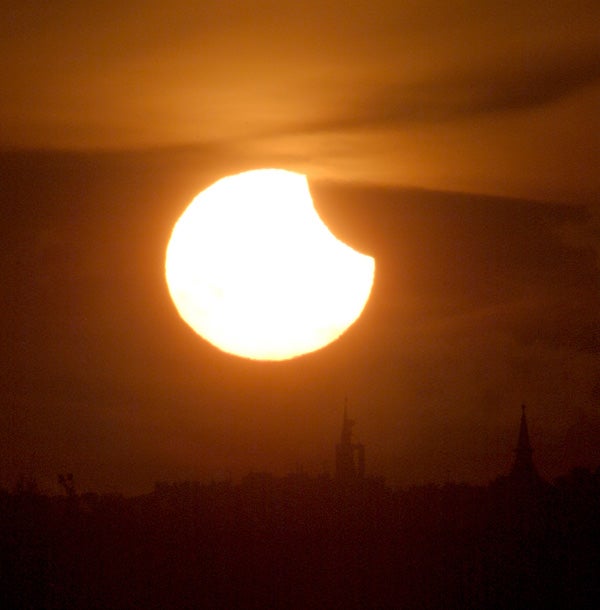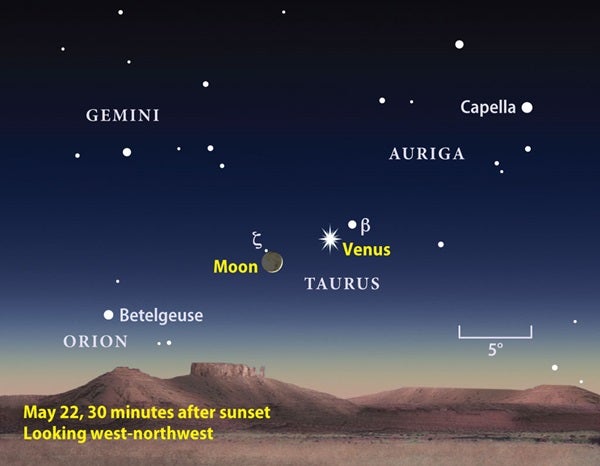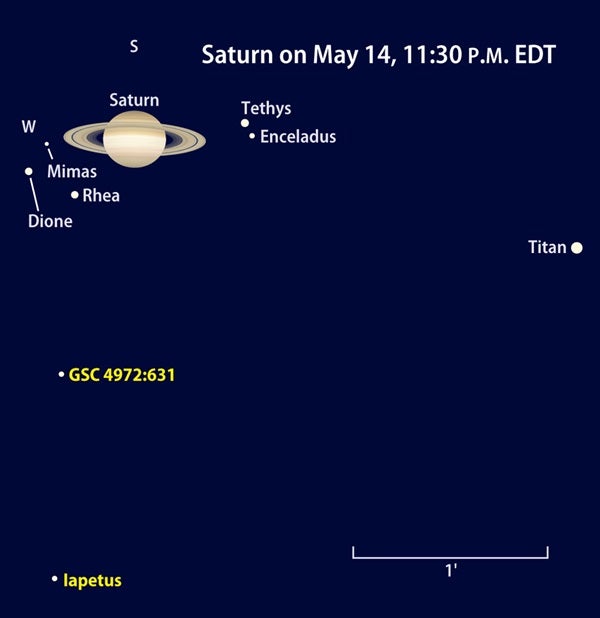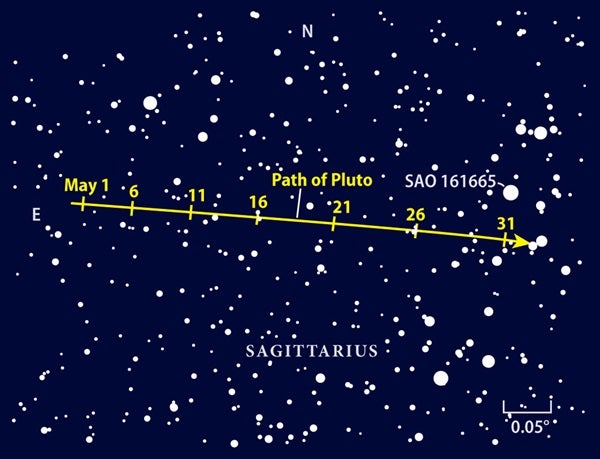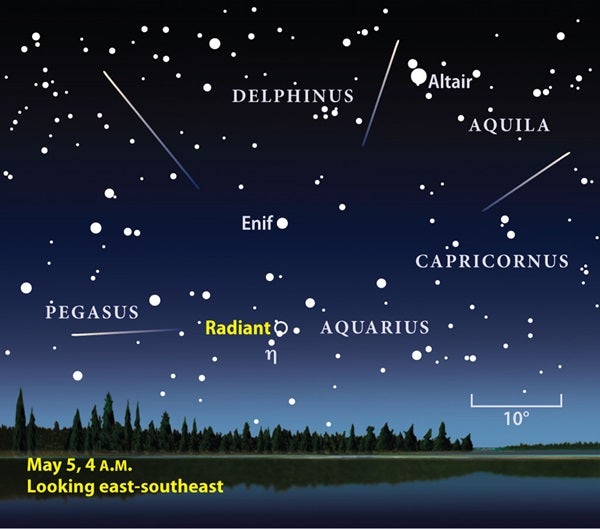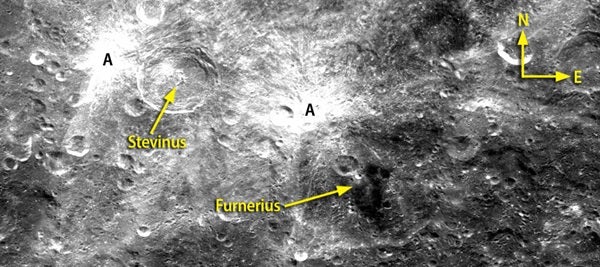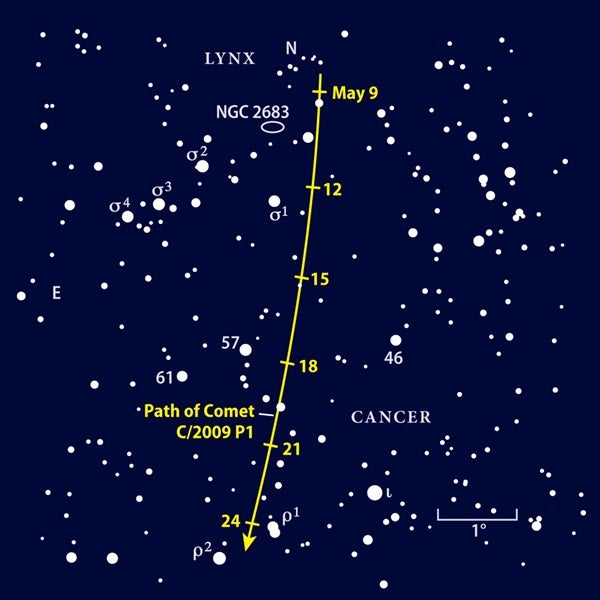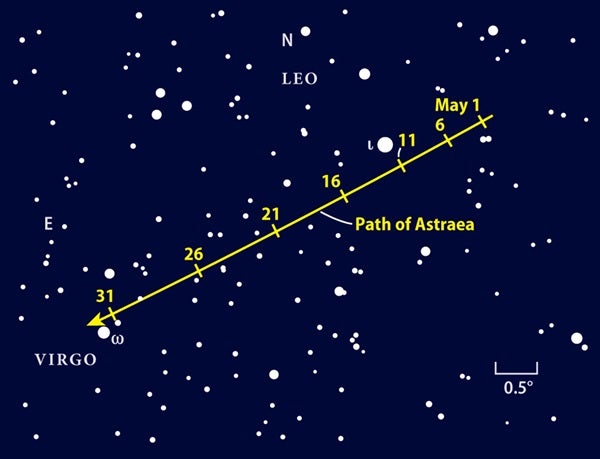The morning sky’s charms prove more subtle. Innermost Mercury lingers in twilight while distant Uranus and Neptune glow dimly low in the predawn sky. And whether or not you call Pluto a planet doesn’t change the fact that it’s difficult to track down.
One solar system event doesn’t require a dark sky, however. On the afternoon of May 20, residents in the western two-thirds of North America can see the Moon pass in front of the Sun and create a partial solar eclipse. Those lucky enough to be within a nearly 200-mile-wide zone that crosses the western and southwestern United States will see an annular eclipse in which the Moon appears entirely within the Sun’s disk, producing the country’s first central solar eclipse in 18 years.
As soon as the sky starts to darken, Venus appears as a brilliant “evening star.” Gleaming at magnitude –4.7 in early May, the planet shows up clearly in the west less than half an hour after sunset. It then stands about one-third of the way to the zenith and doesn’t set until nearly 11:30 p.m. local daylight time.
On May 1, Venus lies 2° below the 2nd-magnitude star Beta (β) Tauri. The two come closer during the next several days, passing within 0.8° of each other May 6. The pair remains above the horizon for more than three hours after sunset.
The two move nearly in tandem during the next couple of weeks. By the 22nd, they lie 2° apart and set some two hours after the Sun. That same evening, a waxing crescent Moon stands 5° south of Venus. For observers in parts of the central and western United States, the Moon passes in front of 3rd-magnitude Zeta (ζ) Tauri during twilight.
The inner planet’s orbit carries it closer to Earth during May. The change in geometry brings with it a dramatic transformation in Venus’ appearance through a telescope.
As May opens, Venus shows a 38″-diameter disk that’s 26 percent lit. Just two weeks later, its disk spans 47″ and appears 14 percent illuminated. When the Moon joins Venus May 22, the two objects’ phases closely resemble each other: Our satellite appears 4 percent lit, and the planet is 7 percent lit (on a disk 52″ across). Venus adds another 5″ to its diameter by the end of May while its phase shrinks to 1 percent illumination — a remarkable sight.
As Venus makes a beeline toward the Sun, the planet is lining up for a rare astronomical event. On June 5/6, Venus will transit the Sun’s face for the second time in eight years but the last time for 105 years. See next month’s Astronomy for more about this special event.
Mars transforms the familiar shape of Leo the Lion this month. On the 1st, the Red Planet lies 6° east of the constellation’s luminary, magnitude 1.4 Regulus. At magnitude 0.0, the planet outshines the star by 3.6 times. Mars moves southeast relative to the background stars during May and ends the month nearly 15° from Regulus. Although the planet still dominates Leo, it has dimmed noticeably to magnitude 0.5.
Mars’ apparent size through a telescope diminishes in lockstep with its brightness. On the 1st, the planet spans 10″ and shows significant detail through a 6-inch instrument. The white north polar cap stands out best because it now tips in Earth’s direction. Dusky surface markings also should be noticeable. By month’s end, the martian disk appears just 8″ across, so you’ll need a 10-inch scope to see appreciable detail.
Saturn reached opposition and peak visibility in April, and it remains a stunning sight through any telescope during May. The beautiful rings span 43″ and tilt 13° to our line of sight at midmonth.
The rings encircle Saturn itself, which measures 19″ across the equator. The globe rarely shows much detail, but surprises do occur. A large storm appeared in the planet’s massive atmosphere in 2010 and easily became visible through amateur scopes. It won’t hurt to keep an eye out for a similar outburst in 2012.
Any telescope reveals Saturn’s biggest and brightest moon, 8th-magnitude Titan. For observers in North America, it lies due south of the planet the evenings of May 4 and 20 and due north May 12 and 28.
Saturn’s two-faced moon, Iapetus, passes north of Saturn in mid-May. This distant satellite varies between magnitude 10 and 12 as it orbits the planet and shows us either its bright icy side (when west of Saturn) or dark dusty side (when east of the planet). As Iapetus passes some 2′ north of the ringed world at midmonth, it glows around 11th magnitude.
Don’t confuse the moon with a similarly bright star the night of May 14/15. The background object, cataloged as GSC 4972:631, lies about halfway between Iapetus and Saturn. A trio of 10th-magnitude moons — Tethys, Dione, and Rhea — gather much closer to the planet along with dimmer Enceladus and Mimas.
That same night, Titan lies as far east of Saturn as Iapetus does north. By the next night, however, Saturn’s westward motion relative to the stars brings the bright moon nearly face to face with GSC 4972:631. Titan then lies just 20″ north-northwest of the star.
The job of finding Pluto’s field of view is a bit easier this month because it’s approaching a line of 7th-magnitude stars. (The brightest of these is SAO 161665.) As May begins, the solar system object lies 0.5° due east of this star. But Pluto wanders slowly westward this month, and you can find it a mere 3′ south of SAO 161665 the morning of May 31.
The first hint of twilight appears around 4 a.m. local daylight time in mid-May. That’s a good time to hunt for Neptune. The outermost major planet then lies about 15° above the southeastern horizon. Glowing at magnitude 7.9, Neptune shows up easily through 10×50 binoculars. First target 4th-magnitude Theta (θ) Aquarii and 5th-magnitude 38 Aqr. Neptune lies below these two and forms a triangle with them, standing 3.3° south of Theta and 2.4° east of 38.
You’ll want to wait until late May to start a search for Uranus through binoculars. This 6th-magnitude planet lies on the border between Cetus and Pisces and doesn’t rise until nearly 3 a.m. local daylight time. By the onset of twilight, it’s only 10° above the eastern horizon. It ends the month 1° northeast of a similarly bright star, 44 Piscium.
You might glimpse Mercury low in the eastern sky just before sunrise in early May. From midnorthern latitudes, it stands barely 3° high 30 minutes before sunrise. (It appears significantly higher from locations farther south.) The innermost planet will be much better placed for northern observers in the evening sky by late June.
Although the Sun interferes with the view of Mercury during May, our star takes center stage May 20. That afternoon, the New Moon passes in front of the Sun and creates an annular solar eclipse for people positioned along a narrow path that runs from Northern California to southwestern Texas. Residents in the rest of the western two-thirds of North America can see a partial eclipse. For details on viewing this eclipse, see “View May’s unusual solar eclipse” on page 48.
The annual Eta Aquarid meteor shower remains active from April 19 through May 28. Most of the meteors, however, encounter Earth within a few days of the shower’s May 5 peak. Unfortunately, Full Moon arrives the same day this year. The bright beacon will wash out fainter meteors and render the brighter ones less impressive.
It’s still worth a look, however. The shower’s radiant — the point from which the meteors appear to emanate — lies near the star Eta (η) Aquarii. This region rises in the east shortly before 3 a.m. local daylight time. Because the Moon lies in the western sky, position yourself where a building or trees block its unwanted light.
These meteors derive from Comet 1P/Halley. Every time Halley passes through the inner solar system, the Sun boils off some of its surface, and Earth slams into this dusty debris every May.
If you observe the Moon around its Full phase, you can’t help but notice the great rayed crater Tycho. Relatively inconspicuous at other times, Tycho comes alive when the Sun shines from nearly overhead and illuminates a vast network of bright streaks that consist of pulverized dust. The impact that created Tycho excavated this material.
Tycho may be the brightest of the rayed craters, but it’s not the only one. Two smaller cousins dominate the southeastern lunar limb around Full Moon. Because the impacts that created these craters happened fairly recently in lunar history, their bright ejecta blankets and rays have not yet darkened under the relentless gales of particles blowing in the solar wind.
Stevinus A appears brighter than Furnerius A, which lies closer to the limb. Stevinus A is also slightly smaller — 5.1 miles across compared with 7.5-mile-wide Furnerius A. Increase your scope’s magnification to separate the two sources of white rays. (Punching up the power also helps tone down the Full Moon’s glare.) The duo straddle the modest Stevinus, which spans about 45 miles. Barely noticeable as the month begins, Stevinus becomes more obvious by May 7 when a lower Sun begins casting shadows.
There are a couple of other ways to reduce the Moon’s brightness if you don’t have a filter designed for this purpose. First, put on sunglasses — most low-power eyepieces have enough eye relief (the distance from the eyepiece’s outer edge to where you see the image best) to let you wear shades. You also can reduce the amount of light entering your scope by using an aperture mask with a 3-inch hole cut in it or by taping a piece of cardboard over the instrument’s front end.
| When to view the planets | ||
| EVENING SKY | MIDNIGHT | MORNING SKY |
| Venus (northwest) | Mars (west) | Mercury (east) |
| Mars (southwest) | Saturn (south) | Uranus (east) |
| Saturn (southeast) | Neptune (southeast) | |
If you want to catch a comet this month, you’ll likely have to pack your scope and drive to a dark site. Unless a comet-hunter discovers a bright newcomer or a known comet undergoes an unexpected outburst, May’s best comet will remain C/2009 P1 (Garradd). And this comet’s growing distance from the Sun and Earth (it’s now more than 200 million miles from both) causes its brightness to drop from 9th to 10th magnitude.
Still, an 8-inch telescope at low power will have no trouble revealing the small fuzzball. Even a 4-inch scope can do the job if you exercise some patience. Make sure that you are well dark adapted and use only a dim red light to illuminate the finder chart at right.
You can locate Garradd about halfway from the western horizon to the zenith just after darkness falls. The comet lies on the border between Lynx and Cancer, a sparse region with few notable stars. Your best bet is to start with the bright stars Castor and Pollux in the constellation Gemini. Garradd stands about 15° above this pair.
Moonlight fills the sky during May’s first and last weeks, so plan your observing sessions for the middle of the month. You can collect a bonus galaxy the evening of May 10 and 11 when Garradd passes less than 1° west of the nearly edge-on spiral NGC 2683. The comet should glow a little brighter overall. At medium power, you might find that the galaxy shape appears more sharply defined than the comet’s comparatively circular glow, which diffuses into the background.
Also be prepared for another intriguing alignment on the evenings of May 24 and 25. Those nights, Garradd passes between the relatively bright stars Rho1 (ρ1) and Rho2 (ρ2) Cancri, a pair of yellow suns separated by just 0.8°.
May lets you choose the asteroid-tracking technique that works best for you. Do you like making an easy hop from a nice guide star? Then the weekend of May 11 and the month’s final few evenings are for you. The main-belt asteroid 5 Astraea slides 0.5° south of 4th-magnitude Iota (ι) Leonis May 11 and 12. By month’s end, the asteroid lies a similar distance northwest of 5th-magnitude Omega (ω) Virginis. This region rides high in the south as darkness falls in May.
Do you prefer challenging your hunting skills? Our prey traverses a thicket of background stars the nights of May 20 to 23. Glowing at magnitude 10.9, Astraea will be well camouflaged, with only its motion to give it away. Make a quick sketch of its star field and then return a night or two later to see which dot moved.
German observer Karl Hencke discovered Astraea accidentally in December 1845 while searching for the asteroid Vesta. Astraea measures only 75 miles across. Dozens of asteroids are bigger than that, and many grow brighter than 10th magnitude. But Astraea wins the lottery this month: The other space rocks either are too close to the Sun, rise well after midnight, or are buried in rich Milky Way star fields.
Martin Ratcliffe provides professional planetarium development for Sky-Skan, Inc. Alister Ling is a meterologist for Environment Canada.

